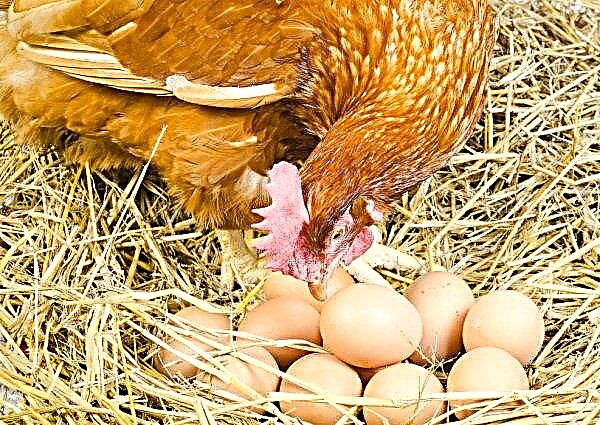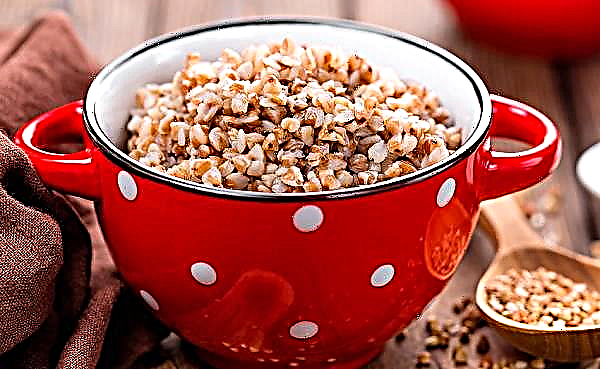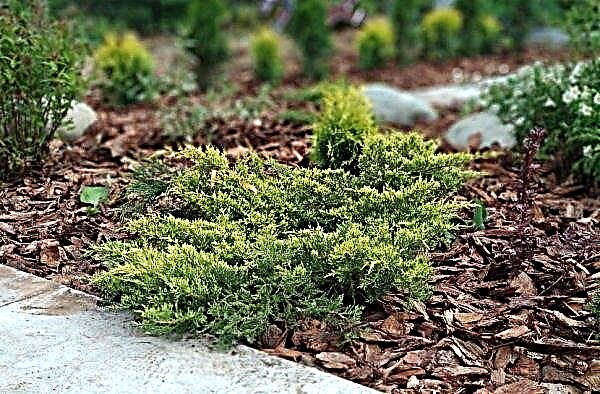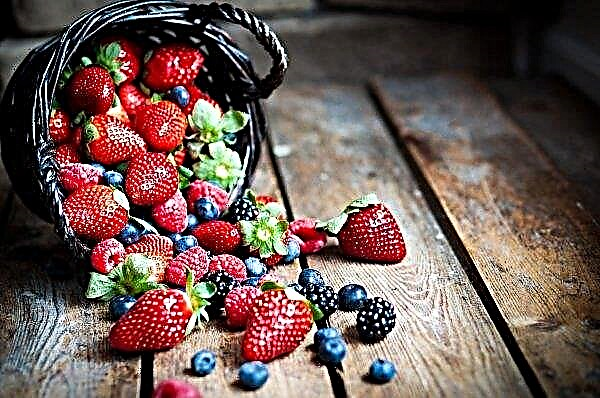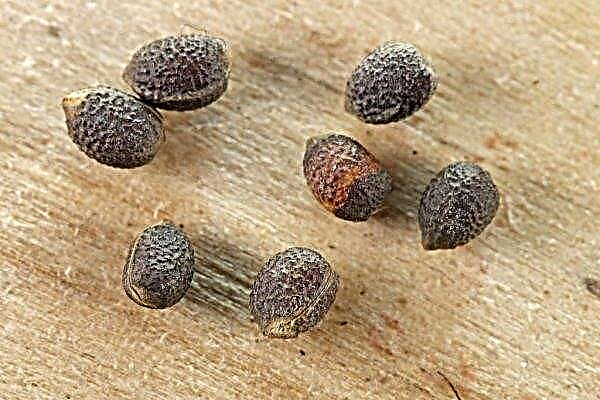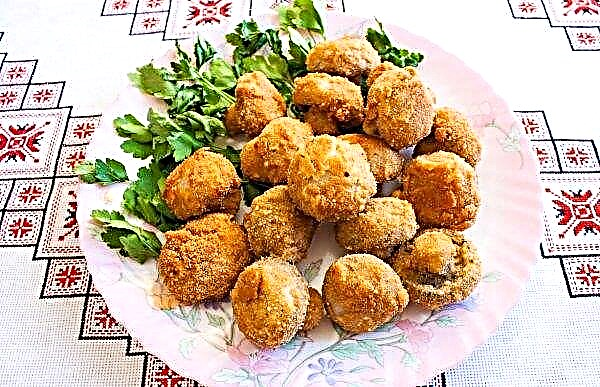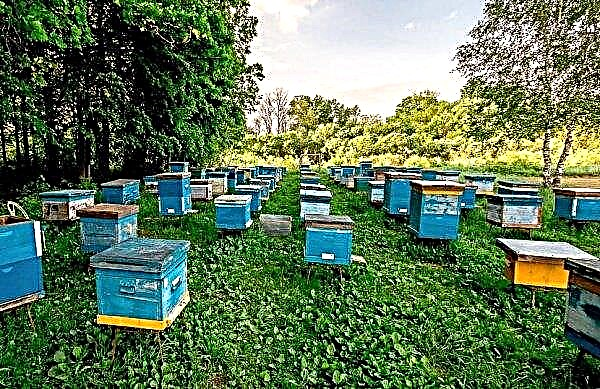Tulips are loved by many gardeners and landscape designers. Due to the abundance of varieties, you can create a huge number of compositions of different shapes and colors. The five leaders in popularity among garden flowers include the terry variety Ice Cream.
Botanical Description
“Ice cream” - the name of the variety is translated from English. At the stage of half-opened petals, the tulip really resembles a horn with ice cream.
The flower head consists of several tiers of petals:
- the outer row is multi-layered, can be painted in red, lilac, pink;
- the inner tier is white, densely terry, much longer than the outer petals.

Botanical grade description:
- The bud is large, can reach 9 cm in height. Having fully blossomed, it is 10 cm in diameter.
- The stem is short and massive, not higher than 40 cm.
- The leaves are dense, like the stem, saturated green.
- Sepals are partially colored in the color of the lower petals.
Did you know? Warriors of the Ottoman Empire painted the image of a tulip on a shield and armor. The drawing was considered a talisman, protection from wounds and death in battle.
Peony flower is resistant to colds and major diseases of the culture. Compared to simple varieties, it blooms late, around mid-May. Long flowering, up to 2 months.
This tulip stands in a bouquet for a long time. To grow a tulip that meets its description, you must follow the instructions for agricultural technology and care for it. Otherwise, a faded and stunted plant will grow.
Tulip planting
It is better to plant flowers in the fall, so that the bulbs have time to take root and in the spring delight the gardener with flowering. Depending on the region, September or October is chosen. The main thing is that the plant takes root before the first frost. In this case, the soil temperature should not be higher than + 10 ... + 12 ° С; in the heat, the bulbs take root worse.
The landing site must meet the following requirements:
- the place should be well lit;
- occurrence of groundwater not higher than 1 m from the surface;
- the plant loves loose, fertile soil with a neutral or alkaline reaction.
2-3 weeks before landing, the site needs to be dug up. When digging in heavy soil, humus, sand and wood ash are added in a proportion of 4 kg / 1 kg / 400 g per 1 m² of land.
Important! Fresh manure is contraindicated as a fertilizer for bulbs. It contains living microorganisms, because of which crops can become sick and die.
Planting material must be pre-processed: soak for 30 minutes in a slightly pink solution of potassium permanganate. Planting depth for large bulbs 20 cm, for small 15 cm from the surface. The distance between the holes is 5–7 cm. After planting, the bed is watered at room temperature with water separated from the water impurities.

Flower care
Ice cream variety loves loose, moderately moist soil. Water the garden every 2-3 days if the weather is hot, in another case every 5-7 days. After watering, a careful loosening of the soil is carried out, no deeper than 10 cm from the surface, so as not to damage the flower.
Important! When using fertilizer, you do not need to exceed the dosage specified in the instructions: an excess of minerals is harmful to the health of the flower.
Varietal plants are capricious, they need a whole complex of minerals for normal development:
| magnesium | for metabolic processes in tissues |
| potassium and boron | stimulates flowering |
| nitrogen | promotes growth and disease resistance |
| phosphorus and calcium | strengthens the root system |
| manganese and iron | participants in photosynthesis are responsible for the production of chlorophyll |
| copper zinc | strengthen protective forces in adverse weather conditions (sharp temperature changes, high humidity). |
Gardeners prefer complex fertilizers containing the entire set of necessary elements. The drug "Kemira Universal-2" has proven itself perfectly. When applied, a solution is prepared in a proportion of 10 g / 10 l of water, fertilized with watering 3-4 times a season with an interval of 2 weeks between procedures.
 To protect the flower beds from insects and diseases, you need to carefully clean the planting from weeds, put traps on slugs and snails - these are the main enemies of the tulip.
To protect the flower beds from insects and diseases, you need to carefully clean the planting from weeds, put traps on slugs and snails - these are the main enemies of the tulip.
Protecting the flower bed from the mollusk is simple: you need to scatter pieces of walnut or egg shells on the outskirts of the flower bed. In addition, you can dust the landing with tobacco dust.
Bulb Storage
When the leaves turn yellow and the buds fade, the gardener proceeds to dig the bulbs. Material extracted from the soil must be cleaned of adhering earth and dry husk particles. Then place it in a thin layer on a piece of cloth or paper to dry under a canopy.
Once again inspect the bulbs and remove dry husk from them, and then put them in a box with ventilation holes and place in a dry place for storage. The temperature in the room should not be below + 4 ° C and above + 10 ° C, it is advisable to regularly ventilate.
Use in landscape design
If the flower zone is divided into separate sections, tulips can be planted in a row, in a succession of different colors. You can create geometric shapes from the plant by placing Ice Cream in the center, and along the edge a variety of plain colors or other bulbous with simultaneous flowering (for example daffodils).

The monochrome flowerbed of plain tulips, but in different varieties, looks great:
- simple;
- terry;
- thick double;
- fringed.
Did you know? The stripes on the petals of two-color tulips were originally the result of a viral disease of plants. Dutch botanist Carol Classius used this moment in breeding.
You can also create a composition of different varieties with different growths - plant flowers in steps. Of great importance is the proximity to other ornamental plants, you need to select non-aggressive neighbors.
For instance:
Flowers have a fibrous root system that does not interfere with bulb development. For a beautiful view of the flower garden all season it is important to choose plants of different flowering periods to hide the ugliness of the bare beds of tulips that are not blooming or already fading.
A delicate flower goes well with perennials:
- day-lily;
- crocus;
- quinodox;
- Muscari
- geranium.
The low, thick double-headed Ice Cream looks good against the background of coniferous ornamental shrubs, spirea, rhododendrons. Variety Ice Cream is a worthy representative of its kind, a delicate, airy and unusual flower. Growing a plant on your site, you must strictly adhere to the rules of agricultural technology.

